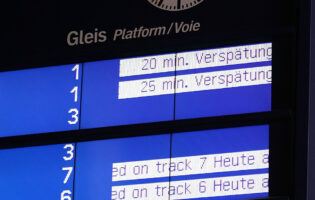
Die Linke via Flickr
The Linke’s Search for Leadership – and Direction

Jonathan Olsen
Texas Woman's University
Jonathan Olsen is Professor and Chair of the Department of History and Political Science at Texas Woman's University. He is the author of four books and has written widely on a variety of political parties in Germany, including the Linke, in such journals as German Politics and Society and German Politics.
Otto von Bismarck is once reported to have said “Faust complains of having two souls in his breast. I have a whole squabbling crowd.” So it is with any leader of the Linke, who must knit together a party which often does more damage to itself through intra-party disputes than it receives from its political opponents. Two weeks ago, Katja Kipping announced that she would not stand again for the position, followed in short order by a similar statement from her co-chair, Bernd Riexinger. Kipping and Riexinger, in office since 2012, symbolize the many-sided face of the Linke. Kipping, once the rising young star in Saxony, was at that time seen as the (mostly) pragmatic leader who could open the party further to younger, urban, “hipper” left-of-center voters able to compete with the Greens even while retaining the core eastern base of the Linke. Riexinger, meanwhile, was the trade union man from the West, one who could speak to the older, left-wing traditionalists in the electorate, those voters and party members who formed the base of the SPD-breakaway WASG before it merged with the PDS to form the new Left Party.
At the time these two party leaders were chosen, the Linke was at something of a high point. In 2009 it had recorded its best election result ever at 11.9 percent. A year after Kipping’s and Riexinger’s selection, the Linke fell back to Earth in the next federal election, albeit with a still respectable 8.6 percent. Although the Linke would improve its vote share slightly in the federal election of 2017, disastrous results in several state elections in the new states from 2016 to 2019 (for which Kipping earned much criticism from the left-wing of the party, as it bled eastern voters to the AfD) as well as its terrible performance (5.5%) in European Parliament elections in 2019 has caused some anxious hand-wringing over the party’s electoral future. This is not to say that the situation for the Linke in 2020 is desperate: Bodo Ramelow still leads the government in Thuringia (thanks to an impressive win in the state election of 2019 and a mishandling of the election of the minister-president by the CDU), it sits in a red-red-green coalition in Berlin and is still firmly electorally anchored across the eastern electoral German landscape, and its gains in western Germany—where the majority of the party’s members now hail from—have been solid. Indeed, the 2019 Bremen state election resulted in a red-red-green coalition, the first of its kind in western Germany. Nevertheless, the Left Party faces many challenges if it hopes to play a decisive role in the next decade of German politics.
The Left Party faces many challenges if it hopes to play a decisive role in the next decade of German politics.
The front-runners for the job of leading the Linke into this new era are two younger women, Janine Wissler (39) and Susanne Hennig-Wellsow (42). Wissler, parliamentary party leader in Hesse, leans to the far left and has expressed deep reservations about entering into coalitions with the SPD and Greens. Preferring to see the party develop deeper roots as a “movement,” Wissler has come under fire for her membership (which she recently resigned) in a far-left faction of the party, “Marx 21,” a group with Trotskyite roots which has been under observation by the Verfassungsschutz for years now. Hennig-Wellsow, parliamentary leader in Thuringia, is on the other hand known as a pragmatic reformer in the mold of Ramelow. She has made little secret of the fact that she sees red-red-green coalitions as an unalloyed good for the party. Although several other possible names for the position of chair have surfaced—Matthias Höhn (MdB and a strong supporter of red-red-green coalitions), Jan Korte (executive director of the parliamentary party in the Bundestag), Ali Al-Dailami, (deputy party chief and one of the most prominent representatives of the far left), or even longtime party stalwart Dietmar Bartsch (who went down to bitter defeat at the hands of Riexinger in 2012)—Wissler and Hennig-Wellsow appear to have the inside track when the party congress convenes on October 31. Furthermore, Wissler and Hennig-Wellsow (who has already welcomed Wissler’s candidacy) may not really be competing with each other so much as competing with one or the other contenders for co-chair as the party works out its careful balancing act between the “squabbling crowd”—and thus the direction of the party. According to its written rules, one of the two slots for party leader is reserved for a woman. According to its unwritten rules (that is to say, its practice for many years), the Linke seek to balance both its eastern and western “wings” but also—and even more importantly—moderate pragmatists and the harder left factions.
Since the mid-1990s, the PDS—and later the Left Party—has often been riven by conflict over when, where, and under which conditions it should seek to enter coalition government.
This last balancing act, symbolized by debates over government participation, has historically been the most difficult for the party: since the mid-1990s, the PDS—and later the Left Party—has often been riven by conflict over when, where, and under which conditions it should seek to enter coalition government. The more realistic the chances for such participation, it seems, the more tumultuous disputes become. In light of the Social Democrats’ recent public support for a coalition with the Greens and Linke at the federal level after the next elections (provided, of course, that it gains a majority, something which remains out of reach at the moment if current opinion polls are to be believed), the stakes of the internal disputes of the Linke—and the selection of the two party chairs—could not be higher. Of course, if such a path-breaking coalition becomes a mathematical possibility, it would still face high policy hurdles (above all in foreign policy, where party orthodoxy still speaks of withdrawing from NATO). Nevertheless, finding the right leaders for its top job remains a crucial precondition. In the rapidly approaching post-Merkel era, with an eastern German populist competitor (AfD) and electoral challenges from a resurgent Green party (and to a lesser extent, SPD), the Linke has little room for error.









